
We’ve waited a very long time for this. The first time Wheels got to try a prototype version of Mazda’s Skyactiv-X petrol compression ignition engine was in Summer 2017. It was clear that there was potential in the technology, Mazda promising the performance of a 2.0-litre MX-5, which gets to 100km/h in seven seconds, with the fuel economy of a 1.5-litre Mazda 2 diesel – a barely credible 2.8L/100km. It sounded almost too good to be true.
Last year, I got to drive the Skyactiv-X engine overseas again, in a pre-production version of the current Mazda 3. This time, the company seemed to have walked back the economy aspirations for the engine, merely claiming that it would offer a 15-17 percent improvement in efficiency over the existing Skyactiv-G 2.0-litre petrol powerplant.
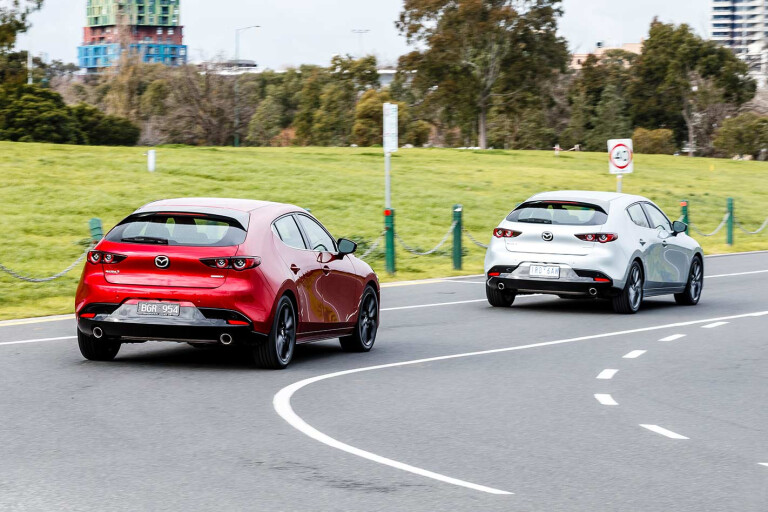
So what we have lined up for you is an objective way to see if Mazda has made good on the claims. Or the latest claims at least. We have a Skyactiv-X for the first time in Australia, and we also have a Skyactiv-G. The pair of them are then subjected to a fuel economy test in both urban and highway environments before we crunch the numbers at the end and see how the Skyactiv-X stacks up.
Before we get into that, what actually is Skyactiv-X tech and why is it important? Squashing an air/fuel mixture until it spontaneously combusts has, until now, been the preserve of diesel engines. In 2008, Mazda started a project to develop a true Homogenous Charge Compression Ignition (HCCI) powerplant but, like Daimler who had tried this before, was defeated by the technical challenges.
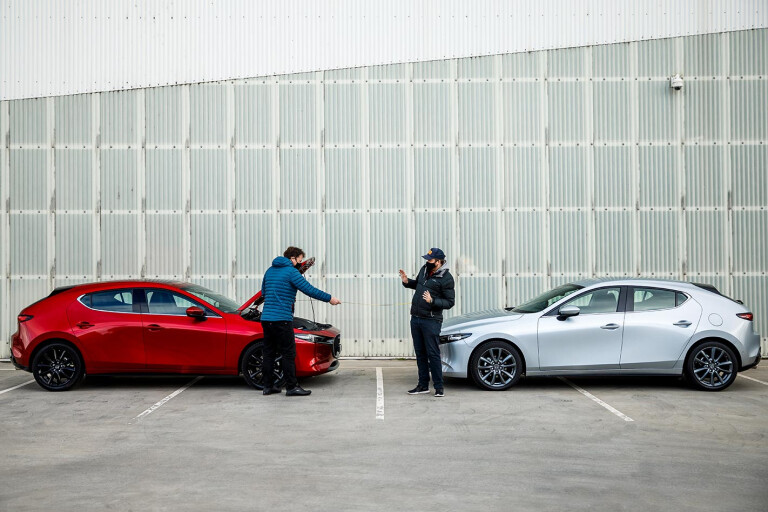
Mazda soon came to the conclusion that the HCCI process was impossible to control. In 2015, the company started using a spark plug to control combustion. If the intake air temperature is too high the combustion rate is too high and the engine is very noisy. If it’s too low, the combustion process is unstable. The intake temperature needed to be maintained within a three-degree Celsius window. Nobody knew how to do this so Hiroshima changed the concept.
Putting a spark plug into a ‘sparkless’ engine would appear to be admitting defeat, but the clever thing is that the spark here is used as a control mechanism. In order for this to work, a radical approach to fuelling was first required. The Skyactiv-X uses a Roots-type supercharger in order to force huge quantities of air into the combustion chamber. In most normal forced induction engines, you need to add a commensurately huge amount of fuel (at a stoichiometric ratio), but Mazda realised that in order for compression ignition to occur, the air/fuel mix had to be fantastically lean.
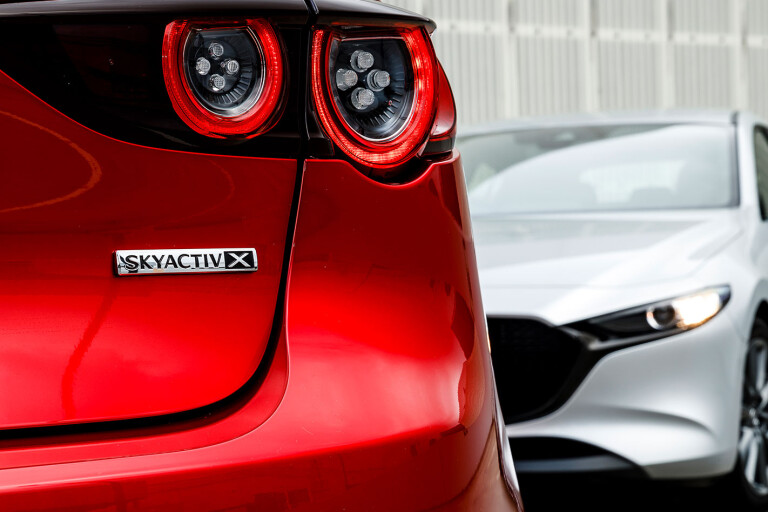
Your car mixes air and fuel in a stoichiometric 14.7:1 ratio. The Skyactiv-X engine, in its lean spark ignition mode, burns in a 29.4:1 ratio, hence the need for the supercharger to get huge quantities of air into the combustion chamber at lower engine speeds. Try to ignite fuel at that ratio and the flame inside the combustion chamber won’t propagate very far and you’d develop a feeble power output.
In such instances, the Skyactiv-X powerplant uses the small fireball from spark ignition as a sort of secondary piston, effectively raising pressure in the rest of the chamber such that compression ignition can kick off.

Spark Controlled Compression Ignition (SPCCI) hands over to normal stoichiometric operation during cold starts, initial warm-up phases and at very high load. Developing a stable switching point between the two combustion modes was one of the biggest technical challenges behind the Skyactiv-X engine.
The good news is that it works and it works beautifully. The hesitance and catarrh-like rattle of the prototype engine has been excised and you’ll only hear some strange acoustics if you really go looking for them by labouring the engine when manually selecting a high gear. In normal driving, you’d be hard pressed to notice much in the way of difference between this and the wholly conventional Skyactiv-G lump, which is exactly as it should be.
The engine note is purposeful and has no diesel-like clatter. The needle fairly rips through the rev range between 3000 and 5000rpm, making its peak power figure of 132kW at 6000rpm while the peak torque figure of 224Nm arrives at 3000rpm. In other words, this is anything but a dull lugger. The X likes a few revs on the board and you’ll certainly find yourself making use of the six-speed automatic’s manual mode to exploit its playful nature. It delivers more enthusiast appeal than the bland 2.5-litre 139kW four-pot that’s also offered in the current Mazda 3 range.
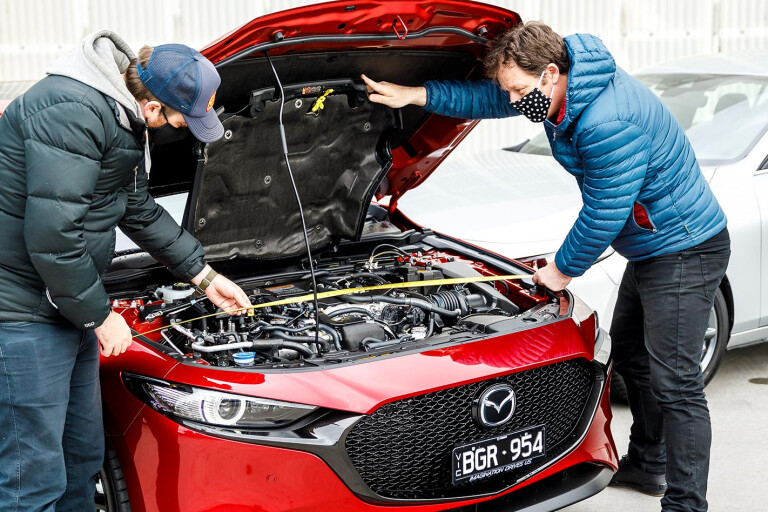
But what of the much-vaunted efficiency benefits? Our fuel test had two separate elements. The first was a 38.2km triangular urban leg through Melbourne, followed by a freeway and country road section of 172.9km. Together these would contribute to a 211.1km combined fuel figure. Elements such as tyre pressures, air conditioning settings, idle/stop actuation and fuel type were normalised across both vehicles.
The Skyactiv-X’s 24v integrated starter-generator means that its idle-stop system helps it eke out better economy in city driving, and while it was quicker and smoother to switch off and on, in some instances, the draw on the system from the air-con would keep the engine ticking over. We’d striven to make this test as real as possible, so we used air conditioning and no arcane hypermiling techniques.
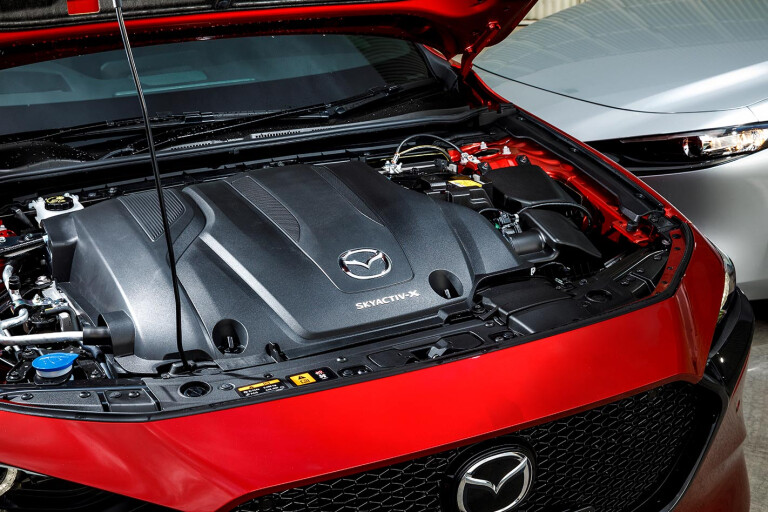
Mazda had claimed that Skyactiv-X would work better with lower-grade petrols, the pre-ignition that this creates in a typical combustion chamber actually being a desirable thing in a sparkless set-up, so we were surprised to open the car’s fuel filler to see an insistence on 95RON juice. That being the case, we fuelled both vehicles with 95RON for consistency, but do bear in mind that the Skyactiv-G unit can run on 91RON fuel which, on the day, was $1.30 a litre versus $1.38 for 95.
And the result? You could barely split the two vehicles. On the urban route, the Skyactiv-X returned 5.65L/100km, while the old-school G engine actually beat it at 5.26L/100km. Out on the open road, the tables were turned, with the Skyactiv-X managing 5.75L/100km against 5.87L/100km for the conventional unit. Crunch the numbers into an overall figure and over the 211.1km route, the Skyactiv-X used 12.1 litres of petrol. The Skyactiv-G drank 12.16L. In other words, the Skyactiv-X sipped 60ml less fuel, realising a fuel saving of 8.3 cents over the three-hour test drive.

Now that may initially seem underwhelming. What’s the point of all that high-tech if the Skyactiv-X unit can’t make any significant saving over Skyactiv-G? Well, consider this.
The compression ignition engine makes 15.8 percent more power. That efficiency gain is effectively coming for ‘free’, in engineering terms at least. Suddenly Mazda’s claim that the engine is between 15 and 17 percent more efficient than the Skyactiv-G is objectively borne out. You may well look at the comparative prices of these engines and wonder whether it’s all been worth it, but as a proof of concept, Skyactiv-X clearly works. Given that this is just Mazda’s first step with this tech, the company certainly has our attention.

THE GOOD AND BAD OF THE 2020 MAZDA3 SKYACTIV-X
Plus: Verve; real world economy; ingenuity; interesting acoustics
Minus: Not the second coming we’d been promised
MAZDA 3 SKYACTIV-X ASTINA HATCH SPECS
Engine: 1998cc 4cyl, dohc, 16v, supercharged
Max power: 132kW @ 6000rpm
Max torque: 224Nm @ 3000rpm
Transmission: 6-speed automatic
Weight: 1416kg
0-100km/h: 8.2sec (claimed)
Price: $40,590
On sale: Now



COMMENTS